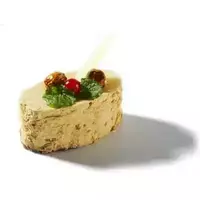Praline

The creation of praline is known to boast the Duke of Plessis-Pralin, originally from France, who came up with an extraordinary exquisite treat in the 17th century, which was an entire almond nut in a sugar caramel shell. A distinctive feature of this dessert was that in the manufacture of praline, each individual nut was given special attention - it was covered with caramel on an individual basis, unlike other sweet dishes in which it is customary to pour nuts all at once.
Over time, immigrants from France and Belgium transferred the recipe for making this treat to the American continent, where it immediately took root. Local confectioners replaced almonds with pecan, which is so popular in those parts, crushed it and mixed it with cream to maintain a sufficient degree of dessert viscosity. This was necessary so that praline could be used as a filling for a variety of sweets.
Today, praline is popular around the world - it is mainly used not as an independent dessert dish, but as an important component in the manufacture of numerous types of cakes, cakes and ice cream. In particular, praline can be used both inside the product (for taste) and outside, acting as excellent decor.
Composition of Praline
Despite the fact that the name of this treat means an entire family of desserts, the composition of praline, which includes nuts and sugar syrup, remains unchanged. At the same time, sometimes crushed nuts are mixed with chocolate or cocoa powder. Such a product in colloquial speech among Europeans is often called Belgian or English chocolate.
Interestingly, praline in Europe is figuratively called any filling for a certain type of candy. And in some languages, the word is often used when referring to an abstract candy filling, not just for a nut in caramel.
Unfortunately, as such, an independent dessert called praline, which was considered an exquisite and very expensive treat in ancient times, does not exist. Today, it is just an ingredient, most often crushed almonds or hazelnuts with sugar caramel, which is quite easy to make yourself.
The composition of praline is simple, as is the recipe for this dish. The peeled nuts are browned in the oven and released from the husks, after which they are mixed with sugar sand and caramelized over low heat until golden. The hot, sticky mass cools and then a hard, vitreous lump of praline is splashed in the mortar and passed several times through the meat grinder.
In fact, the output is what is commonly called praline today. You can use it at your discretion, but do not forget that homemade dessert is not stored for a long time - only a couple of days and then in sealed packaging.
praline 567 kCal
Energy value of praline (Ratio of proteins, fats, carbohydrates - ju):
Proteins: 4.7 g (~ 19 kCal)
Fats: 37.7 g (~ 339 kCal)
Carbohydrates: 52g (~ 208kCal)
Energy ratio (bj | y): 3% | 60% | 37%
 Español
Español Français
Français Português
Português Русский
Русский 简体中文
简体中文 繁體中文
繁體中文 日本語
日本語 한국어
한국어 العربية
العربية Türkçe
Türkçe Қазақ
Қазақ Deutsch
Deutsch Italiano
Italiano Українська
Українська
